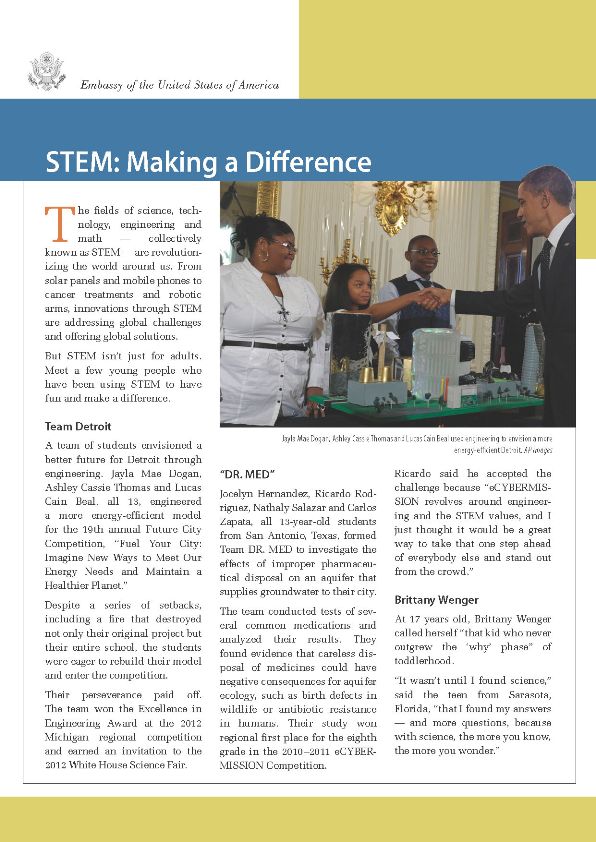The fields of science, technology, engineering and math — collectively known as STEM — are revolutionizing the world around us. From solar panels and mobile phones to cancer treatments and robotic arms, innovations through STEM are addressing global challenges and offering global solutions.
But STEM isn’t just for adults. Meet a few young people who are using STEM to have fun and make a difference.
Team Detroit
A team of students envisioned a better future for Detroit through engineering. Jayla Mae Dogan, Ashley Cassie Thomas and Lucas Cain Beal, all 13, engineered a more energy-efficient model for the 19th annual Future City Competition, “Fuel Your City: Imagine New Ways to Meet Our Energy Needs and Maintain a Healthier Planet.”
Despite a series of setbacks, including a fire that destroyed not only their original project but their entire school, the students were eager to rebuild their model and enter the competition.
Their perseverance paid off. The team won the Excellence in Engineering Award at the 2012 Michigan regional competition and earned an invitation to the 2012 White House Science Fair.
DR. MED
Jocelyn Hernandez, Ricardo Rodriguez, Nathaly Salazar and Carlos Zapata, all 13-year-old students from San Antonio, Texas, formed Team DR. MED to investigate the effects of improper pharmaceutical disposal on an aquifer that supplies groundwater to their city.
The team conducted tests of several common medications and analyzed their results. They found evidence that careless disposal of medicines could have negative consequences for aquifer ecology, such as birth defects in wildlife or antibiotic resistance in humans. Their study won regional first place for the eighth grade in the 2010–2011 eCYBERMISSION Competition.
Ricardo said he accepted the challenge because “eCYBERMISSION revolves around engineering and the STEM values, and I just thought it would be a great way to take that one step ahead of everybody else and stand out from the crowd.”
Brittany Wenger
At 17 years old, Brittany Wenger called herself “that kid who never outgrew the ‘why’ phase” of toddlerhood.
“It wasn’t until I found science,” said the teen from Sarasota, Florida, “that I found my answers — and more questions, because with science, the more you know, the more you wonder.”
A cousin’s battle with breast cancer motivated Wenger to create an artificial neural network to diagnose the disease. She taught a computer how to determine whether a breast mass is malignant or benign by analyzing cells collected from fine-needle aspiration, the least invasive form of biopsy. Her program is now 99.1 percent sensitive to malignancies, with a little more data needed to make it hospital-ready. Wenger’s research won her awards in the Google Science Fair and the Intel International Science Fair.
Wenger said science “gives me an opportunity to be a part of something that can improve the human condition.”
Clara Louisa Fannjiang
As a secondary school student, Clara Louisa Fannjiang of Davis, California, discovered a way to help astronomers who use widely separated radio telescopes on Earth to observe space.
Producing images requires huge amounts of data from the radio telescopes, which are connected to each other by transmission lines. Fannjiang devised a way to determine the best telescope arrangement so that statistics could be used to reconstruct superior images from less information.
At the age of 17, Fannjiang became a prize-winning finalist in the 2012 Intel Science Talent Search. She later began studies at Stanford University.
Naomi Shah
At 17 years old, Naomi Shah was the inaugural first-place winner of the Google Science Fair. Shah, a secondary school senior from Portland, Oregon, developed a biofilter that can be integrated into a heating, ventilation and air conditioning (HVAC) system to make efficient, sustainable and inexpensive clean air more accessible to everyone.
Clean air is especially important to the 300 million people worldwide who suffer from asthma.
Shah’s passion for science, technology and research was sparked at an early age when she visited a local science museum and participated in robotics competitions. Her dream is to become an entrepreneur and inventor focused on public health issues and the environment.
Aidan Dwyer
Aidan Dwyer of Long Island, New York, was just 13 when tangled branches of trees caught his attention. If leaves are the solar panels of trees — collecting sunlight for the photosynthesis trees need to survive — why not mimic them for collecting solar energy for human use?
He built a “solar tree” prototype and compared it against conventional flat-panel solar collectors. He found his tree design made 50 percent more electricity.
“I saw patterns that showed that the tree design avoided the problem of shade from other objects,” he wrote in the paper that helped him win an award in the 2011 Young Naturalist national science competition sponsored by the American Museum of Natural History.
Dwyer has continued to tweak his design to more accurately measure electrical current and power. He filed a provisional patent application to protect his research, which has attracted international attention and which, he said, “could actually change the world.”
